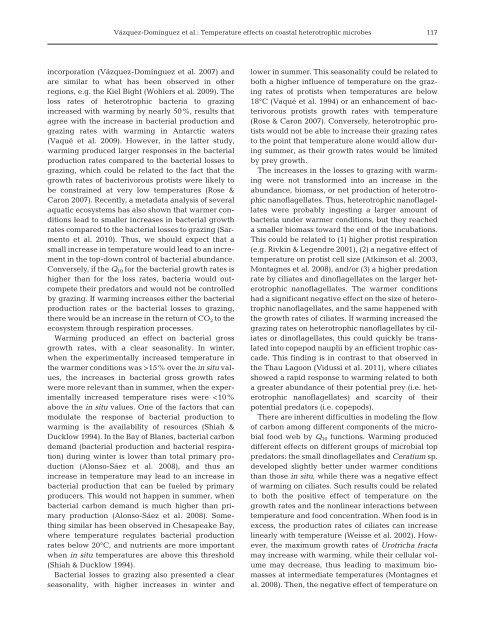Temperature effects on the heterotrophic bacteria, heterotrophic ...
Temperature effects on the heterotrophic bacteria, heterotrophic ...
Temperature effects on the heterotrophic bacteria, heterotrophic ...
You also want an ePaper? Increase the reach of your titles
YUMPU automatically turns print PDFs into web optimized ePapers that Google loves.
Vázquez-Domínguez et al.: <str<strong>on</strong>g>Temperature</str<strong>on</strong>g> <str<strong>on</strong>g>effects</str<strong>on</strong>g> <strong>on</strong> coastal <strong>heterotrophic</strong> microbes<br />
117<br />
incorporati<strong>on</strong> (Vázquez-Domínguez et al. 2007) and<br />
are similar to what has been observed in o<strong>the</strong>r<br />
regi<strong>on</strong>s, e.g. <strong>the</strong> Kiel Bight (Wohlers et al. 2009). The<br />
loss rates of <strong>heterotrophic</strong> <strong>bacteria</strong> to grazing<br />
increased with warming by nearly 50%, results that<br />
agree with <strong>the</strong> increase in <strong>bacteria</strong>l producti<strong>on</strong> and<br />
grazing rates with warming in Antarctic waters<br />
(Vaqué et al. 2009). However, in <strong>the</strong> latter study,<br />
warming produced larger resp<strong>on</strong>ses in <strong>the</strong> <strong>bacteria</strong>l<br />
producti<strong>on</strong> rates compared to <strong>the</strong> <strong>bacteria</strong>l losses to<br />
grazing, which could be related to <strong>the</strong> fact that <strong>the</strong><br />
growth rates of bacterivorous protists were likely to<br />
be c<strong>on</strong>strained at very low temperatures (Rose &<br />
Car<strong>on</strong> 2007). Recently, a metadata analysis of several<br />
aquatic ecosystems has also shown that warmer c<strong>on</strong>diti<strong>on</strong>s<br />
lead to smaller increases in <strong>bacteria</strong>l growth<br />
rates compared to <strong>the</strong> <strong>bacteria</strong>l losses to grazing (Sarmento<br />
et al. 2010). Thus, we should expect that a<br />
small increase in temperature would lead to an increment<br />
in <strong>the</strong> top-down c<strong>on</strong>trol of <strong>bacteria</strong>l abundance.<br />
C<strong>on</strong>versely, if <strong>the</strong> Q 10 for <strong>the</strong> <strong>bacteria</strong>l growth rates is<br />
higher than for <strong>the</strong> loss rates, <strong>bacteria</strong> would outcompete<br />
<strong>the</strong>ir predators and would not be c<strong>on</strong>trolled<br />
by grazing. If warming increases ei<strong>the</strong>r <strong>the</strong> <strong>bacteria</strong>l<br />
producti<strong>on</strong> rates or <strong>the</strong> <strong>bacteria</strong>l losses to grazing,<br />
<strong>the</strong>re would be an increase in <strong>the</strong> return of CO 2 to <strong>the</strong><br />
ecosystem through respirati<strong>on</strong> processes.<br />
Warming produced an effect <strong>on</strong> <strong>bacteria</strong>l gross<br />
growth rates, with a clear seas<strong>on</strong>ality. In winter,<br />
when <strong>the</strong> experimentally increased temperature in<br />
<strong>the</strong> warmer c<strong>on</strong>diti<strong>on</strong>s was >15% over <strong>the</strong> in situ values,<br />
<strong>the</strong> increases in <strong>bacteria</strong>l gross growth rates<br />
were more relevant than in summer, when <strong>the</strong> experimentally<br />
increased temperature rises were
















